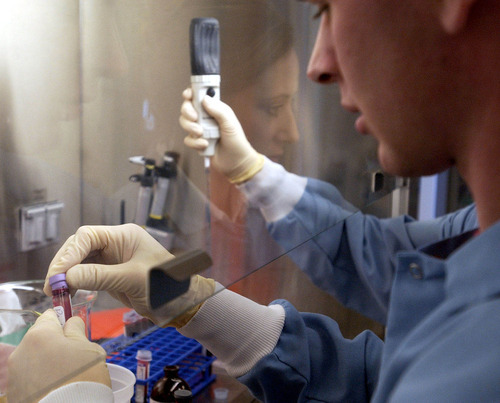This is an archived article that was published on sltrib.com in 2011, and information in the article may be outdated. It is provided only for personal research purposes and may not be reprinted.
Washington • An attorney for the U.S. government has asked a trio of appellate judges to imagine a magic microscope that would allow them to gaze into and through everything in nature, arguing that no company can legally claim ownership over anything seen though such a lens.
If the U.S. Circuit Court of Appeals adopted this novel "magic microscope test," it would eliminate the patents Salt Lake-based Myriad Genetics holds on two genes related to breast and ovarian cancer and overturn 35 years of established patent law. That left one of the judges to admit to being a bit "skittish" about the case.
The panel of judges for the Federal Circuit questioned attorneys for 70 minutes Monday morning and did so before a few hundred spectators, which is an unusually long time for oral arguments and an unusually large crowd.
At the crux of this high-profile case is whether Myriad can patent isolated segments of DNA, the molecules containing the genetic instructions to build life.
The American Civil Liberties Union and the Public Patent Foundation filed suit in 2009 on behalf of researchers and women claiming that such patents wrongly restrict science and make it difficult for women to gain vital medical care.
Myriad, along with the University of Utah Research Foundation, argue the patents allow it to attract the necessary private investment to perform breakthrough genetic research, and a change in law could seriously derail biomedical research.
Federal District Judge Robert Sweet of New York sided with the ACLU in March 2010 on the suit challenging 15 of 179 patent claims Myriad received in the early 1990s for isolating the genes, known as BRCA1 and BRCA2, linked to hereditary forms of breast and ovarian cancer.
The Circuit Court panel is likely to issue a decision on Myriad's appeal in the coming months. No matter how it rules, it's expected the case will get appealed to the Supreme Court.
Myriad's attorney, Gregory Castanias, argued the isolated genes were functionally and structurally different than the same genes attached to a longer DNA sequence.
"These are the products of molecular biologists, not of nature," he said. "Isolated DNA does not exist in nature and never would exist in nature."
He likened it to fashioning a baseball bat out of a tree, but the ACLU's Chris Hansen said that metaphor doesn't fly because you can't dissect a tree and find a baseball bat inside.
Instead, he said what Myriad has done is more similar to a company patenting a kidney after extracting it from a patient.
"The human gene is a product of nature and no more patentable than a human kidney," he said.
The U.S. government, through acting Solicitor General Neal Katyal, got involved in the case recently, asking the Circuit Court to uphold parts of Sweet's ruling and offering his "magic microscope" idea.
He said if courts upheld Myriad's gene patents, then theoretically companies could have patented coal, lithium and even an electron, since they have been isolated from other materials.
"The mere fact of isolating a substance doesn't make it a human invention," Katyal said.
Judge Kimberly Moore, an appointee of President George W. Bush, said the new U.S. position is a significant change, since the federal patent office has issued patents on isolated genes for years.
"I do think this is a pretty dramatic theory that would undo certain patents," she said, offering that such a shift left her skittish. At the same time, she questioned Castanias on why the company should be allowed to patent a gene itself instead of the method of extracting the gene. She also downplayed Myriad's role in isolating BRAC1 and BRAC2.
"All you did is cut off the other stuff," she said.
Judge Alan Lourie, an appointee of President George H.W. Bush, found that extraction significant. He repeatedly questioned Hansen and Katyal on the genes in question, arguing that the breaking of the chemical bonds between genes creates a substance not found in nature.
"It is not just sitting there; it is not just research by tweezers," he said.



